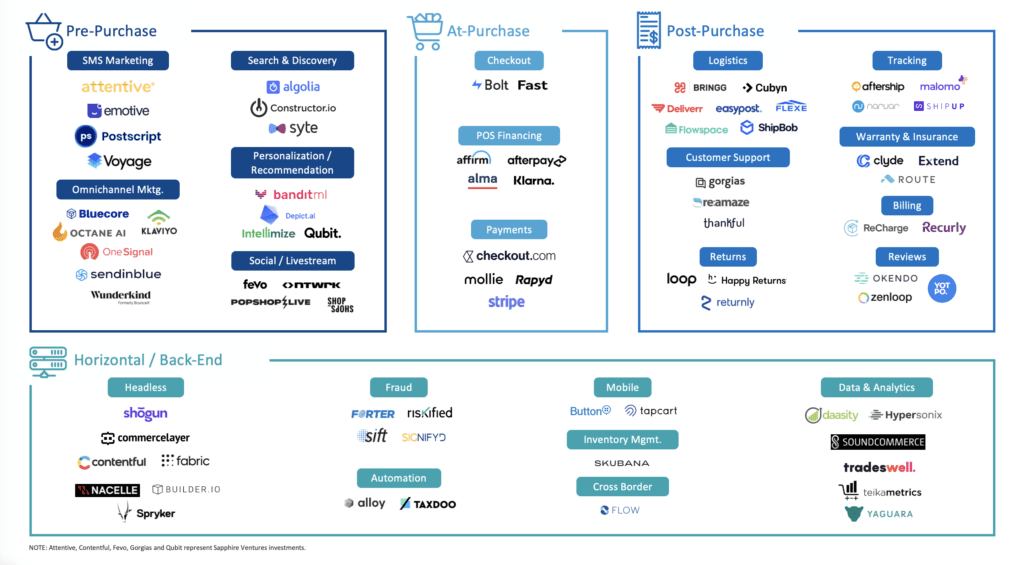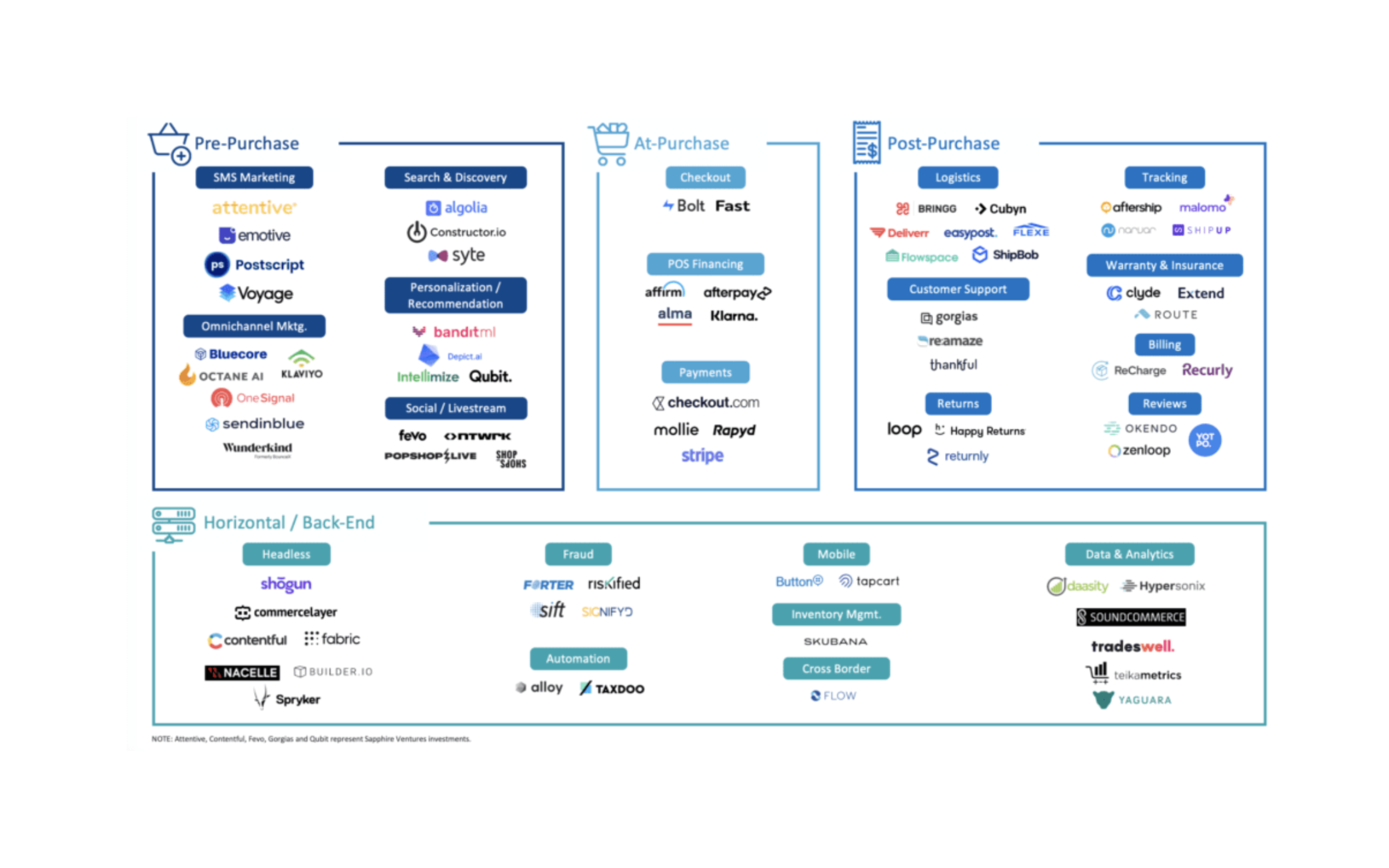It’s safe to say that 2020 was the year of the ecommerce boom. Global ecommerce reached $4 trillion in 2020, growing nearly 30% from the year prior. The pandemic has drastically changed the way we shop, pulling forward the shift from brick-and-mortar stores to online shopping by five years. Today, it’s never been easier to buy everything online — from clothing to groceries to cars — all with the click of a button.
With the rise in online shopping, ecommerce platforms such as Shopify ($140B+ market cap, 1M+ merchants) and BigCommerce ($4B+ market cap, 60K+ online stores) have experienced record highs in growth and valuation. Along with the success of these platforms, we are also seeing an explosion of companies emerge in the broader ecommerce enablement ecosystem. Through tight integrations with underlying ecommerce platforms like Shopify, these new solutions target specific pain points along the customer journey ranging from companies on the pre-purchase side such as Attentive (Sapphire investment) that provides SMS marketing to post-purchase solutions like Gorgias (Sapphire investment) that focuses on customer support. Much like the Salesforce ecosystem, we believe best-in-class solutions will emerge for each category.

As active investors in the space, here are several key trends we see shaping the the future of ecommerce:
- Infrastructure: The Shift to Headless. Ecommerce platforms like Shopify and BigCommerce are built on a monolithic architecture. This means that the frontend, or head (what customers interact with on the site) and the backend, or body (behind-the-scenes admin functions) are tightly coupled together. The challenge with this codependency is that every change made on the frontend needs to be reflected on the backend, making website development highly rigid and cumbersome when it comes to providing the most optimal shopper experience. With a headless architecture, the backend is decoupled from the frontend, and merchants (and their developers) are now equipped with the freedom, agility and speed to create incredibly personalized, creative and dynamic storefronts. For the modern shopper, having a unique user experience becomes especially important in today’s highly crowded digital commerce environment. We see companies like Shogun and Spryker leading the way for the shift to headless. This is an interesting area that we’ll be exploring further, so stay tuned for a detailed thought piece on this topic from the Sapphire team in the coming months.
- Pre-Purchase: All About Social. While our in-person social lives have certainly taken a hit in the pandemic, the online shopping experience is becoming much more digitally social and interactive. You can now easily share and split an online shopping cart with your friends via apps like Fevo (Sapphire investment) or buy products directly while scrolling your Instagram feed. Live streaming has also successfully made its way into ecommerce. Brands and influencers can now engage with viewers live, showcasing products directly via livestreams and enabling viewers to instantly click through to make a purchase (much like a digital QVC) via platforms like PopShop and ShopShops. Social media giants like Amazon, Facebook and YouTube have also all leaned in and launched similar live shopping offerings. In fact, livestream commerce is already a huge phenomenon in China and pulled in over $100B(!) in estimated sales last year. Who would’ve thought QVC-style shopping would make a comeback so soon?
- At-Purchase: Speed is Everything. Think back to the last time you made a purchase online. Chances are you probably had to type out the same credit card and shipping information for what feels like the 100th time. For how close and critical the checkout flow is in getting a purchase over the finish line, the experience today is still highly manual and full of friction (i.e. account creation requirements, payment security concerns, etc.). In fact, 70% of shoppers drop at checkout, and cart abandonment represents a $4 trillion problem globally. For merchants, losing a customer at the final checkout step is tragic, considering all the marketing dollars already spent to not only attract the customer, but also build up the intent to purchase. Companies like Bolt and Fast are building 1-click, secure checkout experiences to make buying effortless for the consumer and drive substantial conversion improvements for the seller. Gone are the days of filling out the same entry forms over and over again in your buying journey.
- Post-Purchase: Building Loyalty with Seamless Support and Fulfillment. Customer support and fulfillment are now more crucial than ever for building customer loyalty and brand. In order to deliver exceptional customer service, online merchants need purpose-built software with deep integrations into the Shopify ecosystem, which is why we partnered with Gorgias last year. Gorgias pulls relevant customer information from various sources onto a single screen and leverages automation to enable even the leanest support teams to respond to customers rapidly. Needless to say, speed is also key when it comes to fulfillment and delivery. Flexe and Flowspace, for example, provide on-demand warehousing, breaking the traditional supply chain paradigm to allow for greater flexibility and speed. Using vendors like Bringg also allows sellers to quickly and easily offer rapid delivery options. Bringg specializes in orchestrating last-mile delivery via software that connects merchants with delivery fleets and optimizes inventory management and driver routing. In today’s delivery-centric world, every minute you can shave off during transit will make a difference.
At Sapphire Ventures, we’re optimistic that companies of consequence will be built to service online merchants, both large and small, and are excited for what’s to come in digital commerce. If you are building a company in ecommerce enablement, we’d love to hear from you!





